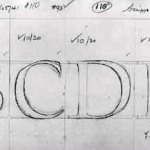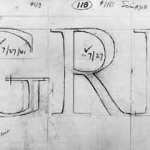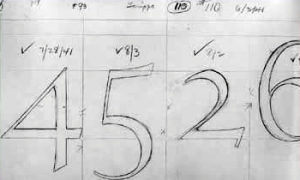The story of how the Scripps College Class of 1941 gave a teaching press complete with a proprietary typeface as its class gift has by now assumed legendary proportions. Late one night, close to graduation, several seniors were talking in Pat Morrison’s room and one said, “Wouldn’t it be wonderful to have a press at Scripps? Let’s do something about it!” Stimulated by this idea, when later lunching with a visiting Frederic Goudy, the group of seniors hung on his every word. Pat Morrison (the granddaughter of California author and friend of the college, Catherine Coffine Phillipes) excitedly suggested, “I wonder if my grandmother would provide the money for a special Scripps typeface?” Made bold by a quick, affirmative phone call, the seniors asked Goudy on the spot to design a typeface for the college.
 This heartwarming and inspiring tale of student enthusiasm raises the question of how these seniors came to appreciate books and fine printing. The knowledgeable skeptic might further ask if even a Frederic Goudy could produce a new typeface in a few months time. These traditional accounts of the beginning of the Scripps College Press are certainly not fabrications; however, there is definitely more to the story. Happily, the answers to our skeptic’s questions are so colorful and impressive as the legend.
This heartwarming and inspiring tale of student enthusiasm raises the question of how these seniors came to appreciate books and fine printing. The knowledgeable skeptic might further ask if even a Frederic Goudy could produce a new typeface in a few months time. These traditional accounts of the beginning of the Scripps College Press are certainly not fabrications; however, there is definitely more to the story. Happily, the answers to our skeptic’s questions are so colorful and impressive as the legend.
In their decision to establish a Press for Scripps College, members of the class of 1941 considered their close relationship to the library. “First, there is this library—with its quiet sense of friendliness and the feeling of deep companionship with people. There is the Gutenberg window, and in the reading room are windows with their printer’s marks. There are books of beauty laid on the desk by Miss Drake, and the Treasure Room in which professors bring to class rare volumes of important authors.” (Barbara Chapine, at the dedication of the class gift.)
 It was to this college with its physical beauty and spirit of intellectual integrity, and to its library, an exquisite gem of architecture, that Dorothy Drake ventured in February of 1938. As Librarian, she was to enrich the lives of generations of Scripps students until 1970. One of her most important goals was to awaken students to books, primarily to the ideas in them, but also to their component features—to design, binding, typefaces, paper—to help develop “discrimination and good taste.”
It was to this college with its physical beauty and spirit of intellectual integrity, and to its library, an exquisite gem of architecture, that Dorothy Drake ventured in February of 1938. As Librarian, she was to enrich the lives of generations of Scripps students until 1970. One of her most important goals was to awaken students to books, primarily to the ideas in them, but also to their component features—to design, binding, typefaces, paper—to help develop “discrimination and good taste.”
Donors had been kind to the library prior to 1938. Among them was Julius Wagenheim of San Diego, an early trustee, who had established the original, large reference collection in the library and had made possible its first treasure room. Another donor was the great San Francisco bibliophile and patron to printers Albert Bender, whose gifts to Scripps in the 1930’s included some 75 volumes of San Francisco fine printing spanning the glory years of the 20’s & 30’s. Ellen Browning Scripps had bequeathed her splendid collection of finely-bound volumes to the College. Through all these treasures and by on-campus talks by collectors and connoisseurs students had been exposed to concepts of fine books and bookmaking.
 Scarcely settled, Dorothy Drake realized that to really teach students about books, to instill an enthusiasm for books, students had to see books. In May 1938, three months after her arrival, Dorothy Drake presented an exhibit of 67 items, loaned primarily by Dawson’s Book Shop. The list is composed of virtual monuments of bookmaking. Included were clay tablets, papyrus, illuminated manuscripts, and printed books from the 15th through the 20th centuries. The checklist of this 1938 exhibition served as the a blueprint for Miss Drake as she began to beguile donors—John Perkins, Benjamin Kirby, Spencer Kellogg, Estelle Doheney, M.S. Slocum. The exhibition itself gave an incomparable visual experience to students of the most excellent examples of design and printing throughout the centuries.
Scarcely settled, Dorothy Drake realized that to really teach students about books, to instill an enthusiasm for books, students had to see books. In May 1938, three months after her arrival, Dorothy Drake presented an exhibit of 67 items, loaned primarily by Dawson’s Book Shop. The list is composed of virtual monuments of bookmaking. Included were clay tablets, papyrus, illuminated manuscripts, and printed books from the 15th through the 20th centuries. The checklist of this 1938 exhibition served as the a blueprint for Miss Drake as she began to beguile donors—John Perkins, Benjamin Kirby, Spencer Kellogg, Estelle Doheney, M.S. Slocum. The exhibition itself gave an incomparable visual experience to students of the most excellent examples of design and printing throughout the centuries.
During the summer of 1938, in July, Frederic W. Goudy at the age of 73 visited Scripps for the first of four visits over the next 3 years. Goudy was in California to consult with the University of California Press on the type he was designing for them. A business friend in Los Angeles who was also a longtime friend of Dorothy Drake was called away unexpectedly; the friend asked Dorothy to entertain Goudy. Of course she did! With that first visit began a friendship and voluminous correspondence that spanned the years until Goudy’s death in 1947.
 On January 12, 1939 Dorothy Drake introduced Scripps students to Frederic Goudy with a Book Talk in the Toll Hall Browsing Room. In what must have been her characteristic lively and contagious enthusiasm, she spoke of her lifelong “hobby” of the history of printing. She told of Frederic Goudy’s background, of his eminence in type design.
On January 12, 1939 Dorothy Drake introduced Scripps students to Frederic Goudy with a Book Talk in the Toll Hall Browsing Room. In what must have been her characteristic lively and contagious enthusiasm, she spoke of her lifelong “hobby” of the history of printing. She told of Frederic Goudy’s background, of his eminence in type design.
Goudy wrote Dorothy Drake in April 1939 that he was to be in Los Angeles on University of California Press business in may. Dorothy Drake arranged for Goudy to visit Scripps again, this time to address the Scripps community at a convocation and to meet faculty, trustees and friends at a dinner. At the may 16, 1939 Convocation, Goudy spoke of letter design and printing, “on the technical principals by which he is guided”. According to an account in the student newspaper, his talk created much interest in printing.
Correspondence between Dorothy Drake and Goudy during the summer of 1939 indicates that she had already planted the idea of special type for Scripps. The summer of 1939—this was a year and a half before the senior class “spontaneously” asked Goudy about the possibility of designing a type for “their” Press!
In a June 11, 1939, letter Goudy mentions the type design for Scripps about which Dorothy had inquired: I take it that a type would be wanted more as a distinctive feature of what would amount to a “private press” operated by members of a college class rather than as a publishing venture? In that case, a minimum of expense would be all, as one or two sizes with maybe italic in same size would give you ample opportunity for the work in mind. Of course, it’s just as much trouble to prepare drawings and patterns for one size as for several, but in the case of Scripps, I would ignore everything except the essentials and more than meet the college halfway in matter of charges. To make the matter more concrete, for a design for a roman face, I never get less than $1000, usually more, for a roman with italic as the same time $1700.
For the sizes and faces Scripps would need, Goudy worked out a budget of $2830. Undaunted by the price, Dorothy Drake wrote again. In a July 4, 1939 response, Goudy mentions another of her ideas in telling of a headdress available for purchase: “as I do not know just what you had in mind regarding a press for Scripps, I can’t make suggestions.” Clearly, the summer of 1939 correspondence indicates that the concept of a private and proprietary type for Scripps was developing long before the 1941 seniors had the ideas! In a letter written on September 8, Goudy wrote: “I have been working on a anew type face with Scripps in mind—it would tickle me if Scripps wanted the type which I think is pretty good, though one never knows what a type would look like from a drawing.”
Reprinted from 1992’s Dorothy Drake and the Scripps College Press,and is written by Judy Harvey Sahak.





